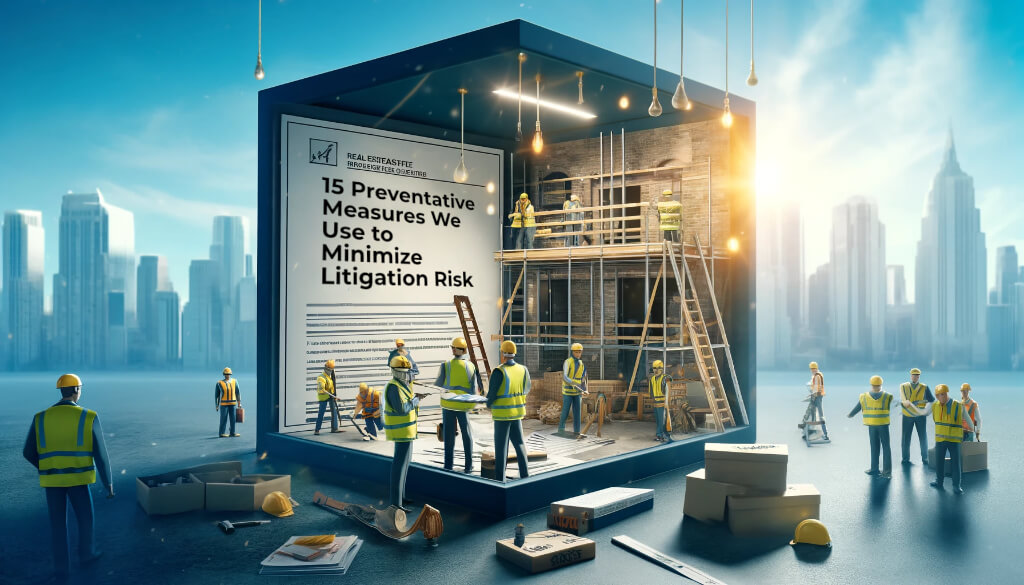
[Image generated with Dall-E]
Sometimes, the only way to win is to avoid playing the game, which applies to litigation. In this post, I outline 15 preventative measures we use to minimize litigation risk that may arise from rental properties.
- Remove garage keypads: You must reprogram the garage door keypad whenever a tenant changes. This is crucial because there could be scenarios where the renovation team forgets to change the code, and the tenant is burglarized. To mitigate this risk, we remove keypads. They are not necessary and are a potential risk.
- Reprogram remote garage door openers: We always reprogram the garage door openers at every tenant turn.
- Secure blocks on the top of block walls: Las Vegas is in the Mojave Desert. Wooden fences are high-maintenance items in a desert, so we don’t buy properties with wood fences. Instead, we only purchase properties with concrete block walls. However, it’s not uncommon to find one or more of the concrete blocks on the top of the walls loose. Concrete blocks are heavy and could injure someone if they fell. Therefore, we carefully inspect the wall and secure any loose blocks.
- Rekey on tenant change: All door locks must be rekeyed each time a tenant change occurs. Failure to do so could lead to unauthorized access and litigation. Therefore, always rekey every lock. Tip: We install Kwikset Smart Key locks, which can be rekeyed by the property manager, thereby avoiding the cost of a locksmith.
- Remove twist lock door knobs on external doors: Many houses have both a deadbolt lock and a door knob with a twist lock. The scenario we want to avoid is locking the door from the inside, walking out without a key, and becoming locked out, and a mishap occurs. We eliminate this risk by replacing door knobs with twist locks with pass knobs (without a twist lock). The deadbolts can only be locked from the outside with a key.
- Remove any overhanging storage mechanisms in garages or unstable shelving units: If there are any flimsy or improperly secured shelves or storage cabinets, we remove them.
- Remove cacti and hazardous plants: Cacti and hazardous plants near walkways are removed to prevent accidental injuries to children, adults, or pets. This ensures safety for anyone who might stumble into the thorns. If such plants are found near walkways or frequently used areas, like a patio, they are replaced with safe plants.
- Remove alarm and camera systems: One potential scenario involves the tenant leaving the property, and during their absence, a burglary occurs. The tenant might claim that the alarm system the landlord provided was faulty.
- Remove trip hazards: Sometimes, we find loose stepping stones, stairs without proper handrails, and similar items that could result in a fall. We take the necessary steps to secure or eliminate the problem.
- Remove mesh screens and rust from side gates and ensure a functioning latch: We commonly see metal gates (vertical metal bars) instead of wooden ones. Many people have pets, so they attach metal grills to the gates to prevent them from walking through the bars. These grills often rust and pose a cut hazard. Many such gates are also rusted, which could be hazards to hands or feet. Therefore, we remove grills, treat the rust, and repaint the gate. We also ensure that the latch functions correctly.
- Secure transition strips: We frequently find loose transition strips between different flooring types. These pose a serious trip hazard, so every transition strip is checked and secured if necessary.
- CO detectors removed or replaced, as necessary: In Las Vegas, the landlord is not required to provide a CO detector. If we find a CO detector in a property, we remove it. Under the lease terms, tenants are strongly encouraged to install one. If there is a fire and a person dies from CO poisoning, and
Ifthe landlord provided a defective CO detector, the resident could claim that the death was the result of a defective CO detector. If the landlord is required to provide a CO detector where your properties are located, I would replace the detector on every tenant turn. - Smoke detectors: If a smoke detector is old or damaged, we replace it. If the detector appears to be working and in good condition, we replace all batteries. If there are not sufficient detectors, we add them. Properly functioning smoke detectors are critical. Also, the lease we use states that it is the tenant’s job to test all detectors once a month and replace the batteries as needed.
- Windows: We check every window for proper operation. If a window does not open properly and there is a fire, it could result in injury or death.
- Water treatment (RO and softener) removed: The reality is that even if the water conditioner is in perfect condition when a tenant moves in, they may not perform the necessary maintenance. This could lead to water contamination. To prevent this risk, we remove all such systems.
How do we ensure that all necessary tasks are conducted during each renovation? We use checklists; we don’t rely on memory. During the final acceptance, the team uses a checklist to confirm that everything has been done correctly.






